
Back to Sidestreet Bannerworks
July 2001
Merlin/Beck 0-4-4-0T
by Marc Horovitz

In 1978 or ’79, Beck, an old German manufacturer of nautical instruments, came out with its first live-steam offering. Anna was an 0-4-0T, designed specifically to be used with LGB rolling stock. It was simple, easy to operate, and robust. Later, an 0-6-2, Helene, similar to LGB’s Zillertal locomotive, was offered. In the planning stages was Bertha, an 0-4-4-0T. The company also had a line of high end, highly detailed, 1:32-scale models of early German locomotives. Sadly, the company went into bankruptcy early in 1981 and its assets (as regards model locomotive production) were acquired by Tom Cooper of Great Britain, who had recently started Merlin Locomotive Works.
One of the first engines produced by Mr. Cooper after the acquisition was his rendition of Beck’s proposed Bertha, released in 1982. This proved to be an unpopular engine and very few were ultimately made. There only two that I am aware of in the USA.
The engine
The locomotive is an odd mix of German ingenuity and Tom Cooper's cavalier approach to engine making. Surprisingly, this is not an articulated engine. Its frame is a (very) rough iron casting. The axles pass through it without benefit of bushings. There is nearly 1/4" of lateral play in all the axles, and it is this slop that allows the locomotive to negotiate curves as tight as LGB’s smallest.
It employs the same technology that Anna and Helene used—piston valve-cylinders controlled by unusual, outside slip eccentrics. The boiler is the single-flue gas type, with a "poker"-type burner. This type of boiler/burner arrangement was originally engineered by Beck, I believe. The technology became the basis for all subsequent Merlin locomotives, as well as engines produced by many other, more recent manufacturers.
There is a minimalist lubricator in the steam dome. The silver dome cap is unscrewed and a few drops of steam oil are placed in the tiny reservoir. I suspect that when the throttle, which is right beneath the lubricator in the steam dome, is opened, all of the oil is sucked immediately into the steam line. In fact, it is only the valves that require internal lubrication. The pistons are each comprised of a pair of Teflon cups, placed back to back and mounted on the piston rod.
The throttle is simply a knob on the right side of the steam dome that releases steam to two lines, one to either side of the engine. All admission lines are copper, fastened to the cylinders via banjo fittings. Exhaust lines are made of various types of rubber. There is a massive gas tank that nearly fills the left-hand dummy water tank. Gas is controlled by a valve that protrudes through the back wall of the cab.
Performance
I'd had several successful runs with this engine many years ago, but it hadn't been run recently. I thought I'd better give it a good going over before steaming it. I found that the front axle was frozen, probably due to rust in the unbushed axle holes. After working with it and running it on air for an hour or so, it became free enough to turn smoothly. After that, it seemed ready to steam.
I filled the boiler, lubricator, and gas tank with the appropriate fluids, then cracked the gas valve and applied a lit match to the stack in the approved manner. The cab was instantly engulfed in flames. I quickly shut off the gas valve and investigated the problem. There was a fault in the valve that allowed the gas to escape into the cab. This engine was clearly a non-runner. When I get some time, I'll figure out what it will take to remedy the problem. I just hope that it won't entail a complete rebuild of the tank.
All Merlin locomotives have names that begin with "M". This one is called Matador, though Mastodon or, perhaps, Maytag, might be more fitting.
| Specifications | |
| Builder | Merlin (Great Britain), from old Beck parts |
| Date built | 1982 |
| Gauge | 45mm (gauge 1) |
| Scale | 1:22.5 |
| Boiler | Single-flue gas boiler |
| Fittings | Safety valve, throttle, pressure gauge, water glass |
| Fuel | Butane gas |
| Blow-off pressure | 30 psi, approx. |
| Cylinders | Four, double acting, piston-valve |
| Reversing gear | Outside slip eccentric |
| Lubricator | Displacement, in the steam dome |
| Dimensions | Length over buffer beams, 12-1/2"; width, 4-1/4"; height over stack, 6-1/4" |
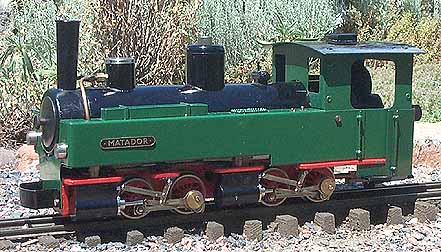
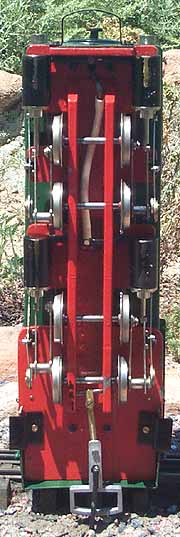
Right: Looking beneath the engine, you can see the rigid iron frame and large amount of side-play in the axles. All cylinders are powered. The white tube in the middle is the exhaust line from the rear pair of cylinders.
Below: Beck locomotives featured unusual outside slip-eccentric reversing gear. This gear has some resemblance to outside Stephenson's. The copper steam line to the rear engine can be seen just above the frame. The braided-metal line is the gas line from the tank to the burner.
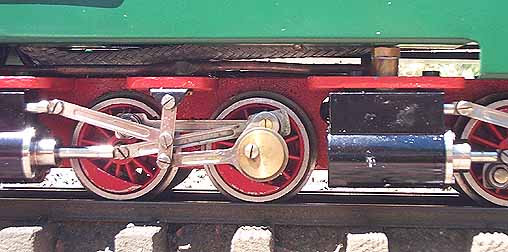
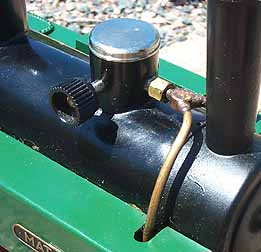

Above right: A large pressure gauge and window-type water glass fill the cab. The gas-control knob is on the left. Crude LGB-style couplers are provided.
Right: A closeup of the underside of the front engine.
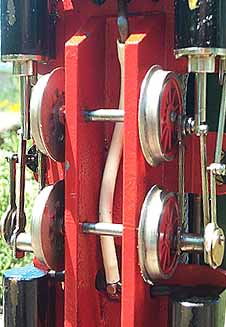
Back to Sidestreet Bannerworks
This page and its contents Copyright Sidestreet Bannerworks, 2001